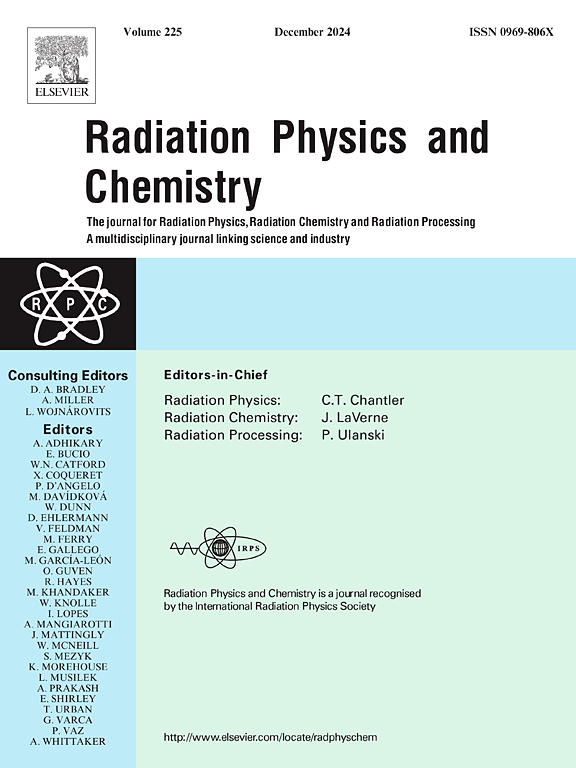Dosimetric and radiobiological comparison of TomoTherapy and IMRT plans for prostate cancer
IF 2.8
3区 物理与天体物理
Q3 CHEMISTRY, PHYSICAL
引用次数: 0
Abstract
The purpose of this study was to investigate the dosimetric and radiobiological parameters of IMRT and TomoTherapy techniques to determine the best technique for the treatment of prostate cancer. Dynamic IMRT and Helical TomoTherapy (HT) radiotherapy techniques were used for the treatment planning of 10 patients with prostate cancer. Tumor Control Probability (TCP) and Normal Tissue Complication Probability (NTCP) based on Lyman-Kutcher-Burman (LKB) and Relative Seriality (RS) models as radiobiological parameters in addition to the multiple dosimetrics including Equivalent Uniform Dose (EUD), Heterogeneity Index (HI), and Conformity Index (CI) were evaluated. The mean NTCP value based on the LKB model for the IMRT method was higher than that for the HT method by approximately 4.62% for the bladder and 4.89% for the rectum, respectively. Similarly, in the RS model, the average NTCP values for IMRT were approximately 4.14% and 12.78% for the bladder and rectum, higher than the HT. The mean values of the HI and CI indices in IMRT were obtained as 0.06 ± 0.01 and 1.13 ± 0.08, respectively. With the HT technique, the index values were equal to 0.04 ± 0.01 and 1.09 ± 0.05, respectively. The mean doses to the rectum and right/left femoral heads were 13.19%, 11.32%, and 10.90% higher in IMRT than in HT, respectively. However, the mean dose to the bladder tissue was 17.13% higher in HT than in IMRT. Our study demonstrated that HT plans were superior to IMRT plans in terms of estimated NTCP using radiobiological models (LKB and RS) for healthily tissues. Except for the higher treatment duration, while having a desired and uniform dose distribution to the tumor, the TomoTherapy technique leads to preservation of healthy organs.前列腺癌 TomoTherapy 和 IMRT 计划的剂量学和放射生物学比较
本研究的目的是调查 IMRT 和断层放射治疗技术的剂量学和放射生物学参数,以确定治疗前列腺癌的最佳技术。研究采用动态 IMRT 和螺旋断层放射治疗(HT)技术为 10 名前列腺癌患者制定治疗计划。除了等效均匀剂量(EUD)、异质性指数(HI)和一致性指数(CI)等多种剂量学参数外,还评估了基于莱曼-库彻-伯曼(LKB)和相对序列性(RS)模型的肿瘤控制概率(TCP)和正常组织并发症概率(NTCP)等放射生物学参数。基于 LKB 模型的 IMRT 方法的平均 NTCP 值在膀胱和直肠分别比 HT 方法高出约 4.62% 和 4.89%。同样,在 RS 模型中,IMRT 的膀胱和直肠平均 NTCP 值分别比 HT 高出约 4.14% 和 12.78%。IMRT 的 HI 和 CI 指数平均值分别为 0.06 ± 0.01 和 1.13 ± 0.08。而 HT 技术的指数值分别为 0.04 ± 0.01 和 1.09 ± 0.05。直肠和右/左股骨头的平均剂量在IMRT中分别比在HT中高13.19%、11.32%和10.90%。但是,HT 对膀胱组织的平均剂量比 IMRT 高 17.13%。我们的研究表明,就使用放射生物学模型(LKB 和 RS)对健康组织进行估计的 NTCP 而言,HT 方案优于 IMRT 方案。除了治疗时间较长之外,TomoTherapy 技术在对肿瘤进行理想和均匀剂量分布的同时,还能保护健康器官。
本文章由计算机程序翻译,如有差异,请以英文原文为准。
求助全文
约1分钟内获得全文
求助全文
来源期刊

Radiation Physics and Chemistry
化学-核科学技术
CiteScore
5.60
自引率
17.20%
发文量
574
审稿时长
12 weeks
期刊介绍:
Radiation Physics and Chemistry is a multidisciplinary journal that provides a medium for publication of substantial and original papers, reviews, and short communications which focus on research and developments involving ionizing radiation in radiation physics, radiation chemistry and radiation processing.
The journal aims to publish papers with significance to an international audience, containing substantial novelty and scientific impact. The Editors reserve the rights to reject, with or without external review, papers that do not meet these criteria. This could include papers that are very similar to previous publications, only with changed target substrates, employed materials, analyzed sites and experimental methods, report results without presenting new insights and/or hypothesis testing, or do not focus on the radiation effects.
 求助内容:
求助内容: 应助结果提醒方式:
应助结果提醒方式:


